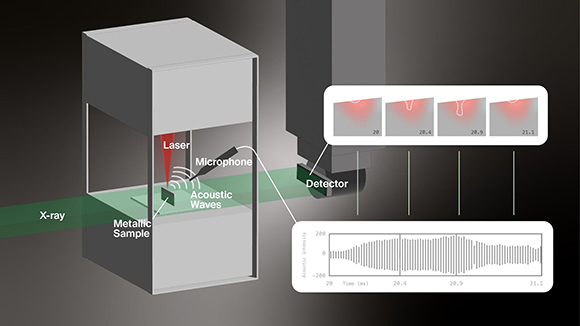EPFL research outlines sonic real-time defect detection laser Additive Manufacturing
January 16, 2024

Researchers at the Laboratory of Thermomechanical Metallurgy (LMTM) at EPFL’s School of Engineering, Écublens, Switzerland, have reported that they have found it possible to detect defects real-time based on the differences in the sound between Additive Manufacturing machines during a flawless build and a build with irregularities.
Traditional monitoring methods, such as thermal imaging and machine learning algorithms, have shown significant limitations, it was stated, often overlooking or misinterpreting defects. This is said to make precision manufacturing elusive and could limit its use in essential industries like aeronautics and automotive manufacturing.
Professor Roland Logé, head of the laboratory, stated, “There’s been an ongoing debate regarding the viability and effectiveness of acoustic monitoring for laser-based Additive Manufacturing. Our research not only confirms its relevance but also underscores its advantage over traditional methods.”
This research is important for the industrial sector as it introduces a cost-effective solution to monitor and improve the quality of products made through Laser Beam Powder Bed Fusion (PBF-LB).
“The synergy of synchrotron X-ray imaging with acoustic recording provides real-time insight into the [PBF-LB] process, facilitating the detection of defects that could jeopardise product integrity,” commented Dr Milad Hamidi Nasab, lead researcher.
In a joint venture with the Paul Scherrer Institute (PSI), Würenlingen, and the Swiss Federal Laboratories for Materials Science and Technology (Empa), the EPFL team formulated an experimental design that melded operando X-ray imaging experiments with acoustic measurements. The experiments were conducted at the TOMCAT beamline of the Swiss Light Source at PSI, with the miniaturised PBF-LB machine developed in the group of Dr Steven Van Petegem. The amalgamation – with an ultra-sensitive microphone, positioned inside the build chamber – pinpointed distinct shifts in the acoustic signal during regime transitions, thereby directly identifying defects during manufacturing.
A pivotal moment reported in the research was the introduction of an adaptive filtering technique by signal processing expert Giulio Masinelli from Empa. “This filtering approach,” Masinelli emphasised, “allows us to discern, with unparalleled clarity, the relationship between defects and the accompanying acoustic signature.”
Unlike typical machine learning algorithms, which excel at extracting patterns from statistical data, but are often tailored to specific scenarios, this approach provides broader insights on the physics of melting regimes, while offering superior temporal and spatial precision.
These findings from EPFL are anticipated to have significant implications for potential industrial applications, particularly in the aerospace and precision engineering sectors. The study is said to underscore the need for consistent manufacturing techniques and suggest the potential for early detection and correction of defects, enhancing product quality.
Professor Logé concluded, “This research paves the way for a better understanding and refinement of the manufacturing process, and will ultimately lead to higher product reliability in the long term.”
Download Metal AM magazine

















